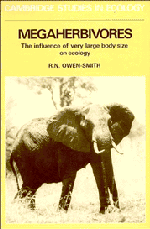Book contents
- Frontmatter
- Contents
- Preface
- 1 Prologue
- 2 Morphology, evolutionary history and recent distribution
- 3 Food and other habitat resources
- 4 Space–time patterns of habitat use
- 5 Body size and nutritional physiology
- 6 Body size and feeding ecology
- 7 Social organization and behavior
- 8 Life history
- 9 Body size and sociobiology
- 10 Body size and reproductive patterns
- 11 Demography
- 12 Community interactions
- 13 Body size and population regulation
- 14 Body size and ecosystem processes
- 15 Late Pleistocene extinctions
- 16 Conservation
- 17 Epilogue: the megaherbivore syndrome
- Appendixes
- References
- Index
3 - Food and other habitat resources
Published online by Cambridge University Press: 01 June 2011
- Frontmatter
- Contents
- Preface
- 1 Prologue
- 2 Morphology, evolutionary history and recent distribution
- 3 Food and other habitat resources
- 4 Space–time patterns of habitat use
- 5 Body size and nutritional physiology
- 6 Body size and feeding ecology
- 7 Social organization and behavior
- 8 Life history
- 9 Body size and sociobiology
- 10 Body size and reproductive patterns
- 11 Demography
- 12 Community interactions
- 13 Body size and population regulation
- 14 Body size and ecosystem processes
- 15 Late Pleistocene extinctions
- 16 Conservation
- 17 Epilogue: the megaherbivore syndrome
- Appendixes
- References
- Index
Summary
Introduction
The habitat resources of interest to this chapter are those that individual animals of a species depend upon for their survival. These include food sources, surface water, and refuges from weather extremes.
Food
For large herbivores dietary intake may be characterized either in terms of (i) the plant species eaten, (ii) the plant parts ingested, or (iii) the nutrient contents of the ingested material.
In terms of plant species, the basic classification is in terms of the graminoid: dicotyledon proportions (including non-graminaceous monocots with dicots). The leaves of grasses have higher contents of fibrous cell wall components, and digest more slowly, than the leaves of woody and herbaceous dicots. Silica bodies present in grass leaves further reduce digestibility and also abrade teeth. However, the leaves of woody dicots are ultimately less digestible than those of grasses, due to a higher proportion of indigestible lignin incorporated in the cell wall. Furthermore, the leaves of woody and herbaceous dicots frequently contain toxic or digestibility-reducing compounds, which are much less common in grasses.
In terms of plant parts, the proportions of foliage, stemmy material and fruits in the diet are of interest. Supporting tissues such as stems and bark tend to be high in indigestible fiber, while fruit pulp and seeds contain stores of soluble carbohydrates. Leaves contain the photosynthetic enzymes and are highest in protein and minerals (apart from calcium), although protein content declines as leaves age and fiber contents increase.
- Type
- Chapter
- Information
- MegaherbivoresThe Influence of Very Large Body Size on Ecology, pp. 30 - 52Publisher: Cambridge University PressPrint publication year: 1988



